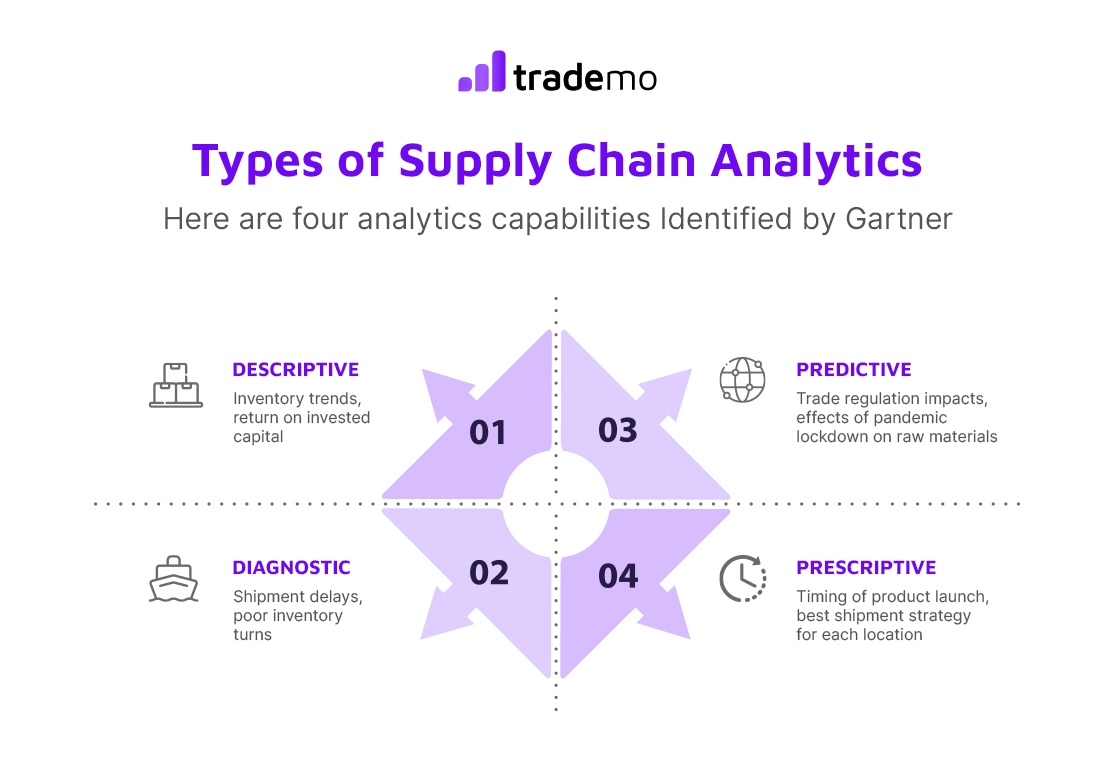Webinars & Videos
Watch videos featuring supply chain experts
A supply chain management team cannot be successful without proper supply chain analytics. The right analytics at the right time can help you protect your supply chains from disruption, gain a competitive edge, and increase revenue for your business.
With how advanced ML/AI technologies and mathematical analytics models have become, supply chain analytics can also help you drive efficiency and lower resource costs for your supply chains. So let’s jump right into it!
The word “supply chain analytics” is self-explanatory. Supply chains generate a lot of data. SCA is simply the analysis of the global import export data.
With these analytics, you can create data-driven insights to help create better strategies for your business supply chain and its various aspects such as procurement, processing, and distribution of commodities.
Modern supply chains are large, complex, and at first glance, incomprehensible. Supply chain analytics can help throw light on a business’s supply chains. Here’s why SCM analytics are important:
Better risk management: Supply chain bottlenecks and disruptions can slow down your supply chains significantly. With supply chain analytics, you can find out the risks that your supply chain is currently facing by observing your supply chain data and predicting potential risks.
Simplifying supply chain planning: Using supply chain data feeds into your analytical engines, you can find new ways to optimize your supply chain and improve your overall supply chain’s performance.
Take optimal business decisions: With supply chain data analytics, you can prepare and predict the changes you need to make in your business. With the help of AI/ML tools, businesses can even gain an edge over their competitors with the help of the insights they create.
Achieving operational resilience: Resiliency in supply chain is an increasingly important aspect of supply chain management. This resiliency can be achieved with the help of supply chain insights derived from analytics.
Gartner’s guide on data divides analytics into 4 broad categories. All these categories can apply to supply chains for different use cases.

Let’s discuss them in detail:
1. Descriptive supply chain analytics: Descriptive analytics for supply chains is the measurement of historical supply chain data used to find patterns and trends. For example, this data can help you find your best-selling products, supply chain bottlenecks, etc.
2. Diagnostic supply chain analytics: Diagnostic analytics for supply chains help identify why bottlenecks, disruptions, and supply chain errors occur. For example, a supplier that does not fulfill their orders regularly.
3. Predictive supply chain analytics: Predictive analytics for supply chains uses AI/ML technologies on historical data to help identify potential bottlenecks, disruptions, or changes within business supply chains.
4. Prescriptive supply chain analytics: Prescriptive analytics for supply chains is often used for making supply chain decisions based on logical decision-making algorithms. Decisions such as new product launches, discounted products, and order quantity planning require the use of prescriptive analytics.
As discussed above, supply chain analytics is used by businesses to gather and process supply chain data to create insights. SCA delivers real and lasting value for the businesses that implement and utilize them.
Here are the various ways businesses can leverage these analytics:
SCM analytics requires massive amounts of data. How does a supply chain management team figure out what data to use? The answer is simple. All the data that it can possibly find!
Supply chains are complex webs of cooperation between multiple parties. A single manufacturer can have multiple suppliers for each raw material they need. They can also have multiple shipping lines, freight forwarders, trucking companies to deliver these goods. Not to forget, finished goods also have to be sent to their respective vendors adding to the complexity.
Any amount of data you can find, you will need. A proper supply chain management system can help keep track of these complex links that make up your supply chain.
If you import or export your goods, you will need statistical trade data and supply chain data for your suppliers and trade lanes. You can find that data with Trademo Intel. Intel’s trade data can also also be used for competitive analysis as it will provide you with supply chain data for your competition.
Supply chain analytics is as old as supply chains themselves. However, analytics in supply chains have evolved a lot over the years. Before the advent of computing and ML/AI tech, the field of analytics itself was rather simple.
Since the time Henry Ford created assembly lines(1923), some basic forms of supply chain management & analytics began. However, the true push for analytics came post-1958, when IBM started using processing data with the help of mainframe computers. This data processing was revolutionary giving rise to the terms “analytics” & “business intelligence.”
While this wasn’t applied to supply chains directly at the time, analytics found its way within the supply chain space with the advent of the internet in the 1990s. Technology researchers in the 90s found ways to collect data for products moving within supply chains. Analysis for this data was rather basic during the time.
Alongside the Internet, came theoretical concepts such as IoT and CEP which are now possible two decades later. These theoretical concepts when applied in a supply chain help analyze supply chain data which forms the base of SCA.
The impetus for analytics truly came with the rise of supply chain intelligence in the last 10 years. Its true potential is yet to be seen in the coming years.
Already discussed above, supply chain analytics can have long-term effects on your supply chain management. Even the smallest change can have far-reaching effects.
Despite its benefits, implementing supply chain analytics can be difficult for most businesses.
The importance of SCM analytics is unprecedented. In a time when disruptions in the supply chain are common, such analytics can help you gain a competitive edge and protect your supply chains from slowing down to a halt.